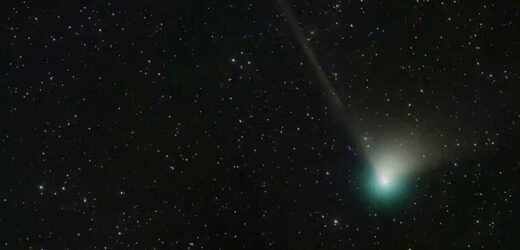Kreutz comet disintegrates as it travels towards sun
We use your sign-up to provide content in ways you’ve consented to and to improve our understanding of you. This may include adverts from us and 3rd parties based on our understanding. You can unsubscribe at any time. More info
Comet C/2022 E3, which orbits the sun every 50,000 years will be closest to the Earth next Wednesday and Thursday. It was discovered last March by astronomers at the Zwicky Transient Facility at the Palomar Observatory in California.
The comet, comes from the Oort cloud on the edge of the solar system will shoot past the earth next week at a distance of 2.5 light minutes or 27 miles.
Comets are made up of primordial dust and ice that travel around the sun in giant elliptical orbits.
As they get closer to the sun, the bodies warm up therefore turning surface ice into gas and dislodging dust.
As a result, a cloud or coma is created surrounding the comet’s hard nucleus and the dusty tail that stretches out behind.

Images of the C/2022 E3 show a green glow that is thought to come from the presence of diatomic carbon.
This is pairs of carbon atoms bound together in the head of the comet.
Over the last month, astronomers have captured stunning images of the comet with telescopes.
They have shown the body’s head, dust tail and the more tenuous ion tail.
The comet’s cosmic ice ball has been bright enough to spot with the naked eye in rural areas with limited light pollution.
In recent days the comet has been easier to spot with a telescope or binoculars.
Stargazing apps like Night Sky, SkyView and Sky Guide are very useful as they can help budding astronomers find the precise location of the comets.
It is visible in the Northern Hemisphere, clouds permitting, as the sky darkens in the evening.
DON’T MISS:
Britons warned of new log burner rule changes with old stoves banned [REVEAL]
UK boilers to carry ‘secure, homegrown’ gas alternative within months [INSIGHT]
Spectacular Taurid meteor shower to soar above UK this weekend [SPOTLIGHT]
Next week it is heading for a fly-by of the pole star the brightest star in Ursa Minor.
However, there is a short window for viewing the comment with the best views being had on February 1 and 2.
By the middle of February the comet will have disappeared from view as it travels back out into the solar system on its return trip to the Oort cloud.
Source: Read Full Article


